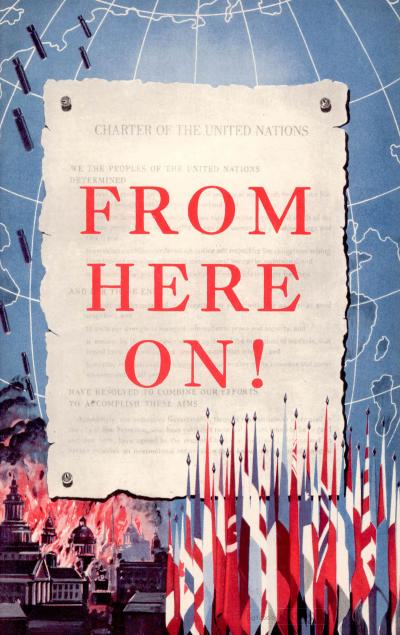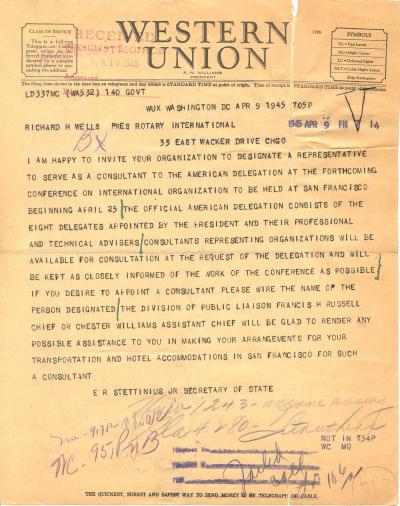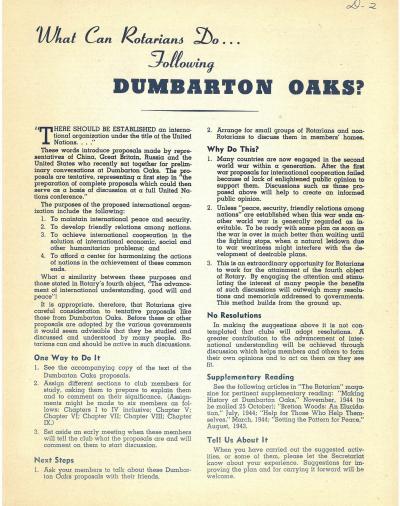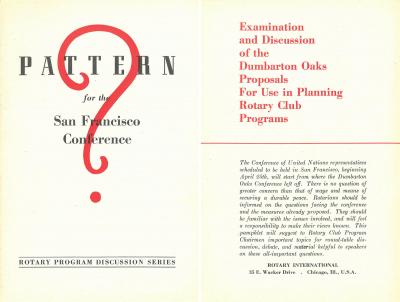Rotary History
Rotary at the start of the United Nations
Rotary and the United Nations have a shared history of working toward peace and addressing humanitarian issues around the world.

Rotary's presentation of the United Nations charter, "From Here On!"
During World War II, Rotary informed and educated members about the formation of the United Nations and the importance of planning for peace. Materials such as the booklet “From Here On!” and articles in The Rotarian helped members understand the UN before it was formally established and follow its work after its charter.
Many countries were fighting the war when the term “United Nations” was first used officially in the 1942 “Declaration by United Nations.” The 26 nations that signed it pledged to uphold the ideals expressed by the United States and the United Kingdom the previous year of the common principles “on which they based their hopes for a better future for the world.”
Officials from Great Britain, the Soviet Union, and the United States met in Moscow in 1943 and called for the creation of an international organization to maintain peace and security.
The next year, representatives of those countries plus China held conferences in Washington, D.C., to discuss how to go about this monumental task. Those sessions became known as the Dumbarton Oaks conference, where delegations from the four countries developed a proposal for the structure of the new organization.
After the conference, Rotary published “What Can Rotarians Do Following Dumbarton Oaks?” It included the proposed charter, talking points, and suggestions for discussing with club members how the United Nations would relate to Rotary’s goal of advancing international understanding. It also emphasized the importance of having a plan ready for when the war ended, rather than waiting until the fighting stopped.

Telegram inviting Rotary International to serve as a consultant to the U.S. delegation to the San Francisco Conference.

“Timely Questions on Dumbarton Oaks” helped Rotarians understand the complexities of the proposed charter.
After World War I, “proposals for international cooperation failed because of lack of enlightened public opinion to support them,” it explained. Discussions among members “will help to create an informed public opinion.”
“Timely Questions on Dumbarton Oaks” followed to help Rotarians understand the complexities of the proposed charter. The flyer presented different perspectives on the security council and other aspects of the UN as topics for Rotary club programs or discussions. At the same time, governments around the world were carefully studying and reacting to the work done at Dumbarton Oaks.
From April to June 1945, delegations from 50 nations attended the United Nations Conference on International Organization in San Francisco (often known as the San Francisco conference). Their task was to write a charter acceptable to all of them. The delegations were assisted in this historic effort by a large number of staff, advisers, and consultants.
Rotary International was one of 42 organizations the United States invited to serve as consultants to its delegation at the San Francisco conference. Each organization had seats for three representatives, so Rotary International’s 11 representatives served in rotation. The people officially representing Rotary included the general secretary, the editor of The Rotarian, and several past presidents. Other Rotarians from Africa, Asia, Europe, and North and South America served as members of their own nations’ delegations. Rotarians also served as consultants to their national delegations.

Pattern for the San Francisco Conference
Just before the meetings began, Rotary International published and distributed the “Pattern for the San Francisco Conference” pamphlet. “It is a splendid opportunity for the individual Rotarian to fulfill the objective of International Service,” the document proclaimed, “by taking part in the debate on this scheme of world government.”
Throughout the rest of 1945, The Rotarian and other publications kept Rotary members informed about issues and developments related to the new organization. Editorials and articles clarified issues, provided additional insights and talking points, and updated readers on what was happening and the people involved:
- “Rotarians in the News at San Francisco,” July 1945
- “Report from San Francisco,” July 1945
- “Rotary at the Conference,” July 1945
- “Gateway to Peace,” August 1945
- “San Francisco Just Started It,” November 1945
After the UN was established, the 95-page booklet “From Here On!” contained the exact text of the UN Charter on one side of every two-page spread with annotations and questions designed to stimulate discussion on the other. With this layout, Rotarians could use it to learn and lead club discussions.
The Charter, it explained, would be effective only if “free citizens” worldwide were determined to give it vitality. “The Rotarian faithfully following these pages,” the booklet said, “will find himself treading the path to service.”
In 1946, Rotary published a supplement listing the major accomplishments of the meetings held by the UN General Assembly in January and February of that year. Later articles in The Rotarian kept the United Nations and its work on the minds of members:
- “UN or World States,” June 1946
- “What Do You Want UN to Do?” September 1948
- “Speaking of the United Nations,” March 1955
- “Appraisal at San Francisco,” September 1955
- “How I Would Change the UN,” October 1955
Today, Rotary holds the highest consultative status offered to a nongovernmental organization by the UN’s Economic and Social Council, which oversees many specialized UN agencies. The Rotary Representative Network maintains and furthers its relationship with several UN bodies, programs, commissions, and agencies. This network consists of Rotary International representatives to the United Nations and other organizations.
Rotary Day at the United Nations each year celebrates the organizations’ shared vision for peace and highlights the critical humanitarian activities that Rotary and the United Nations lead around the world.